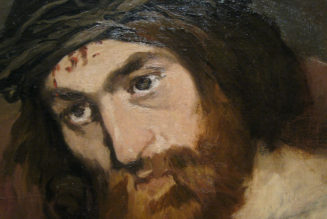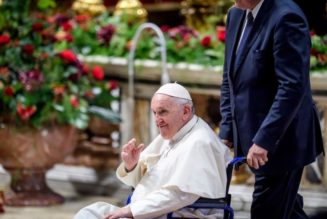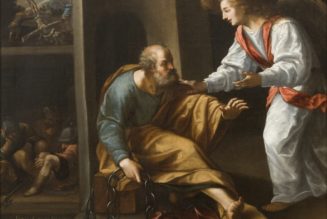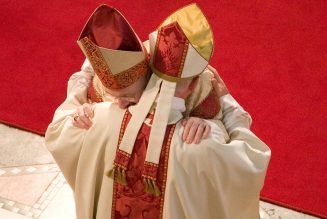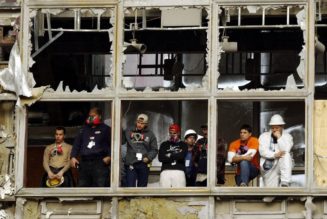Fifty years ago, then-Fr. Joseph Ratzinger and Ida Friederike Görres were watching their era’s equivalent of a livestream of the implosion of the Church in Europe. And they were asking the same questions about the “reformers” in the Church that many of us are asking today:
Why are they so optimistic about their efforts that are patently leading to a decline in the Church? And why do these people remain in a Church they so clearly despise? And, daring to utter the s-word, when will the powers that be finally pull out a red card and declare, “schism”?
In the early 1970s, Ratzinger was a rising young prelate and Görres was an elderly lay author near the end of her life. Their lives intersected. Ratzinger and Görres carried on a correspondence from the 1960s until her death in 1971, when Ratzinger gave the eulogy at her funeral.<a href="https://www.crisismagazine.com/opinion/why-do-heretics-remain-in-the-church#easy-footnote-bottom-1-99315" title="Joseph Ratzinger, “Eulogy for Ida Friederike Görres,” trans. Jennifer S. Bryson, Logos: A Journal of Catholic Thought and Culture 23, no. 4 (September 9, 2020): 148–55.”>1
Orthodox. Faithful. Free.
Sign up to get Crisis articles delivered to your inbox daily
form.fluent_form_4 .ff-t-cell {padding: 0px;}
form.fluent_form_4 .ff-t-cell:last-of-type {width: 60%;}
form.fluent_form_4 .ff-el-form-control {padding: 18px 16px 19px!important; border-radius: 2px 0 0 2px!important;}
form.fluent_form_4 .wpf_has_custom_css.ff-btn-submit {border-radius: 0 2px 2px 0;}
} .fluentform_wrapper_4{ margin: px; } .fluentform_wrapper_4{ padding: px; } .fluentform_wrapper_4 .ff-el-group.ff_submit_btn_wrapper { text-align: center; }.fluentform_wrapper_4 .ff_submit_btn_wrapper .ff-btn-submit { background-color: rgba(0, 68, 177, 1);padding-top: 20px;padding-left: 10px;padding-right: 10px;padding-bottom: 20px; }.fluentform_wrapper_4 .ff_submit_btn_wrapper .ff-btn-submit:hover { background-color: rgba(253, 159, 1, 1); }
When it came to the destroyers in the 1970s, Ratzinger noticed that optimism was a central characteristic. He developed three hypotheses to explain their optimism. In a talk Ratzinger gave on “Hope” in 1986, he used the Church in Holland in the early 1970s as one of his case studies of hope’s incompatible counterpart, optimism.<a href="https://www.crisismagazine.com/opinion/why-do-heretics-remain-in-the-church#easy-footnote-bottom-2-99315" title=" Joseph Ratzinger, To Look on Christ: Exercises in Faith, Hope, and Love (New York: Crossroad, 1991), 40–42.”>2 He described how the state of the Church in Holland was a much-discussed topic among his confrères at the time.
After a visit to Holland, one of them brought back a report of “empty seminaries, religious orders with no novices, priests and religious who in shoals were turning their backs on their vocation, the disappearance of confession, the dramatic decline in Mass attendance, and so on.” What came as “the real surprise,” said Ratzinger, was the prevalence of “optimism.” Ratzinger recounted how the returning visitor to Holland told them:
Nowhere was there any pessimism, everyone was looking forward to the morrow with optimism. The phenomenon of general optimism allowed all the decadence and destruction to be forgotten: it sufficed to make up for all that was negative.
Ratzinger explored three hypotheses for this optimism in the face of unambiguous collapse.
One was that “optimism could possibly be merely a cover behind which lurked the despair that one was trying to overcome.”
A second hypothesis, he said, “could be something worse.” He explained:
Possibly this optimism was the method come up with by those who desire the destruction of the old Church and under the guise of reform wanted without much fuss to build a totally different Church, a Church after their own taste.
Ratzinger mused that such destruction would be “Something they could not set in motion if their intention was noticed too soon.” He identified that this second hypothesis required two types of optimism: that of the destroyers and that of naive followers.
Thus, the image of “the public optimism” maintained by the destroyers “would be a way of reassuring the faithful in order to create the climate in which one could dismantle the Church as quietly as possible and gain power over it.” To make this second approach possible, reflected Ratzinger, it was necessary to have “the trustfulness, indeed the blindness of the faithful who let themselves be reassured by fine words.”
He concluded, “this optimism of the arrogance of apostasy would however make use of a naive optimism on the other side and indeed deliberately nurture it.” This type of optimism would be presented deceptively as if it “were nothing other than…the divine virtue of hope,” when, however, “in reality it is a parody of faith and hope.” This second type of optimism, he said, would be “a deliberate strategy to rebuild the Church so that…our own will” not God’s, “would have the last word.”
His third hypothesis was that “this optimism…was simply a variant of the liberal faith in continuous progress—the bourgeois substitute for the lost hope of faith.”
Ratzinger concluded that likely all three types of optimism were at work, “Without it being easy to determine which of them had the decisive weight and when and where.”
In 1970, there was another hypothesis about the Dutch forerunner of today’s Synodal Way, this time developed by Ida Görres. In a letter to her friend Fr. Paulus Gordan, OSB, she explained that a priest brought materials from the Church in Holland. She responded, “In view of this, I cannot understand why, in Rome, one does not simply declare schism, which has in fact long since taken place”—a schism, she said, that “is now only disguised with the contemptuous formulas of diplomacy.” Then she explained why from the other side, in Holland, those who have essentially left the Church show no eagerness to step out the door:
The gentlemen in Holland are surely clever enough to know that, officially detached, they would sink into the abyss of uninteresting insignificance, whereas this way, they, of course, go on and on playing a splendid sensational role and yet, at the same time, do what suits them.<a href="https://www.crisismagazine.com/opinion/why-do-heretics-remain-in-the-church#easy-footnote-bottom-3-99315" title="Ida Friederike Görres, Letter to Paulus Gordan, January 30, 1970 in “Wirklich Die Neue Phönixgestalt?” Über Kirche Und Konzil; Unbekannte Briefe 1962-1971 von Ida Friederike Görres an Paulus Gordan, ed. Hanna-Barbara Gerl-Falkovitz (Heiligenkreuz im Wienerwald, Austria: Be+Be Verlag, 2015), 439–440. Quotes translated by Bryson.”>3
Bright, cheery optimism and love for media attention are on display again today among the enthusiasts of the Synodal Way in Germany. Year after year, more and more Germans are leaving the Church; but at the Synodal Way they’re more optimistic than ever. They enthuse about a future with women’s ordination, allowing divorce, extending the sacrament of marriage to same-sex pairs, and so on. And they’re quick to make their case known in any media channel they can. And all the while they “do what suits them” not what suits the Church. body .novashare-ctt{display:block;position:relative;background:#fd9f01;margin:30px auto;padding:20px 20px 20px 15px;color:#fff;text-decoration:none!important;box-shadow:none!important;-webkit-box-shadow:none!important;-moz-box-shadow:none!important;border:none;border-left:5px solid #fd9f01}body .novashare-ctt:hover{color:#fff}body .novashare-ctt:visited{color:#fff}body .novashare-ctt *{pointer-events:none}body .novashare-ctt .novashare-ctt-tweet{display:block;font-size:18px;line-height:27px;margin-bottom:10px}body .novashare-ctt .novashare-ctt-cta-container{display:block;overflow:hidden}body .novashare-ctt .novashare-ctt-cta{float:right}body .novashare-ctt.novashare-ctt-cta-left .novashare-ctt-cta{float:left}body .novashare-ctt .novashare-ctt-cta-text{font-size:16px;line-height:16px;vertical-align:middle}body .novashare-ctt .novashare-ctt-cta-icon{margin-left:10px;display:inline-block;vertical-align:middle}body .novashare-ctt .novashare-ctt-cta-icon svg{vertical-align:middle;height:18px}body .novashare-ctt.novashare-ctt-simple{background:0 0;padding:10px 0 10px 20px;color:inherit}body .novashare-ctt.novashare-ctt-simple-alt{background:#f9f9f9;padding:20px;color:#404040}body .novashare-ctt:hover::before{content:”;position:absolute;top:0px;bottom:0px;left:-5px;width:5px;background:rgba(0,0,0,0.25);}body .novashare-ctt.novashare-ctt-simple .novashare-ctt-cta,body .novashare-ctt.novashare-ctt-simple-alt .novashare-ctt-cta{color:#fd9f01}body .novashare-ctt.novashare-ctt-simple-alt:hover .novashare-ctt-cta,body .novashare-ctt.novashare-ctt-simple:hover .novashare-ctt-cta{filter:brightness(75%)}
We are, by now, in the umpteenth episode of the umpteenth season of a tragic series known as “The Crisis in the Church.” In the latest episode, the Synodal Way in Germany, which has already strewn outrage after outrage on its path, is now embracing one heretical set of views after the other and doing so ever more brazenly.
And as we watch the livestream of this, again, and still, we are asking: Why are these people who pursue destruction so filled with optimism? When will enough be enough for de facto schism to be declared openly? And why do these people who hate the Church remain in her?
- Joseph Ratzinger, “Eulogy for Ida Friederike Görres,” trans. Jennifer S. Bryson, Logos: A Journal of Catholic Thought and Culture 23, no. 4 (September 9, 2020): 148–55.
- Joseph Ratzinger, To Look on Christ: Exercises in Faith, Hope, and Love (New York: Crossroad, 1991), 40–42.
- Ida Friederike Görres, Letter to Paulus Gordan, January 30, 1970 in “Wirklich Die Neue Phönixgestalt?” Über Kirche Und Konzil; Unbekannte Briefe 1962-1971 von Ida Friederike Görres an Paulus Gordan, ed. Hanna-Barbara Gerl-Falkovitz (Heiligenkreuz im Wienerwald, Austria: Be+Be Verlag, 2015), 439–440. Quotes translated by Bryson.


